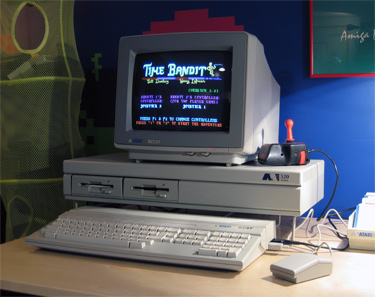Some of you out there have likely read Tracy Kidder’s Pulitzer Prize-winning book The Soul of a New Machine, an inside look at the experiences of a group of Data General engineers in creating a new minicomputer back in the ’70s. I only discovered this book, myself, four or five years ago. It’s an extremely enjoyable read that set me searching for similar, up-close looks at the creation stories of some of the microcomputers that I know and loved in my youth.
I’ve managed to find a few such titles that I’ve enjoyed greatly, including:
- The Little Kingdom by Michael Moritz — An inside look at Apple in the early ’80s, very similar in style to Kidder’s work.
- Steve Jobs & The NeXT Big Thing by Randall E. Stross — A look at Steve Jobs’ creation of NeXT Computer after his ousting from Apple in 1985. The book provides a detailed look at the company but, interestingly, was published in 1993, before NeXT took over Apple and NEXTSTEP became Mac OS X.
- On The Edge: The Spectacular Rise and Fall of Commodore by Brian Bagnall — A behind-the-scenes look at the creation stories of Commodore computers, from the PET to the Amiga.
- Dealers of Lightning: Xero PARC and the Dawn of the Computer Age by Michael A. Hiltzik — A close look at the creation of so many key computing technologies that sprang from a little research lab set in the hills of Palo Alto, back in the ’70s.
- Revolution in the Valley: The Insanely Great Story of How the Mac Was Made by Andy Herzfeld — A series of short anecdotes that together provide an interesting look at how the Macintosh came to be.
- Insanely Great: The Life and Times of Macintosh, the Computer That Changed Everything by Steven Levy — The author’s account of his first experiences with the prototype Macintosh and a look at its first 10 years.
- The Ultimate History of Video Games: From Pong to Pokemon–The Story Behind the Craze That Touched Our Lives and Changed the World by Steven L. Kent — A rather detailed look at the pinball and early arcade and home console video game scene, and the companies behind it.
- Revolutionaries at Sony by Reiji Asakura — The story that is the making of the Sony Playstation.
Some of these are out of print and required a little digging to get my hands on, but all are well worth a read. These books touch on many of the systems that I spent real time with over the years, but conspicuously absent is a look at the creation of the Atari ST, a machine with which I spent most of my free time during ’86 and ’87. I’ve never seen the saga of this fast-tracked, 16-bit Atari told in any detail. That is, until I ran across a series of posts on the unassuming blog of a man who was a member of the Atari ST design team.
Landon Dyer ended up working for Atari in the early ’80s thanks to entering an Atari-sponsored programming contest in which he submitted an assembly-based Centipede clone written on his Atari 400 hooked to a black and white TV. (The author of Atari’s “official” Centipede cartridge called Dyer’s version better than his own.) Flash forward a few years — Jack Tramiel buys Atari and Dyer finds himself one of the lucky few not laid off, and on the Atari ST team.
His two-part blog post gives some very nice details regarding just what was going on behind closed doors while the Atari ST was in the oven.
Before the ST hardware started to work, we had to use existing 68000-based systems for cross development. The graphics guys had Apple Lisas that were running CP/M-68K; the Lisas had nice bitmap displays which we used as “practice” STs. The disks on these machines took forever to come back after a crash (tens of minutes). For some reason the boot code on these machines had been written to display a bitmap of a fish. You’d hear a mutter or curse from down the hall (crash), then the creaky footsteps of someone walking around, cooling their heels and waiting for their “God damned” Lisa Profile drives to boot, then a triumphant yell “CarpDOS!” and typing sounds.
Don’t miss this very enjoyable read or Dyer’s blog, DadHacker (which has been online since mid-2002 (UPDATE: and, sadly, is online no more, checking in in 2024 – links updated to Wayback Machine), chocked full of excellent geek content. Hats off, Landon.
Links: The Atari ST (part 1), The Atari ST (part 2), How the Atari ST almost had Real Unix



Thanks for the link to the ST developer’s blog. i often wondered about the development of that system. It seems like every other system out there has a development story behind it but I know next to nothing about the 16 and 32 bit Atari computers.
You may also like the following books:
Racing the Beam which is a book about how the Atari 2600 was created, and The Chip which explains how the microchip was invented, back in the 60s. Oh and also Piloting Palm which is sort of the Palm Pilot equivalent of Revolution in the Valley.
Thanks for the book tips. I’ve got Racing the Beam on my iPad (via Kindle) and read about half of it, but it’s a little less engrossing to me than I’d hoped. Piloting Palm sounds interesting — I’d never heard of it — but it might be too depressing to read about the heady days at Palm, looking at how severely they dropped the ball and lost the crown.
Hi Blake, great list. Was wondering if you’ve read Cringley’s Accidental Empires? It’s choke full of anecdotes, opinionated and over-the-board and I love it for that, really curious on your thoughts